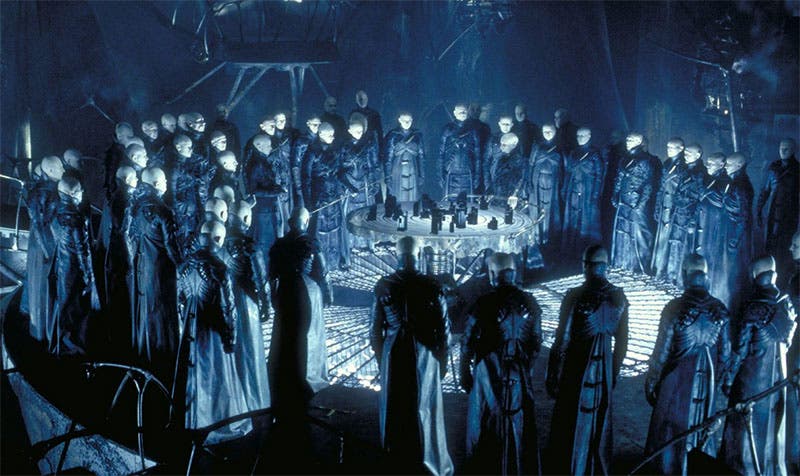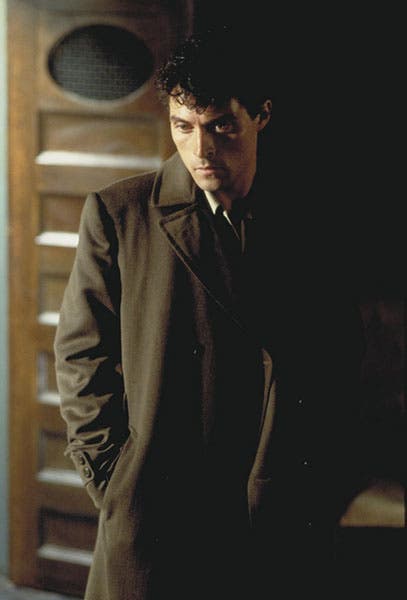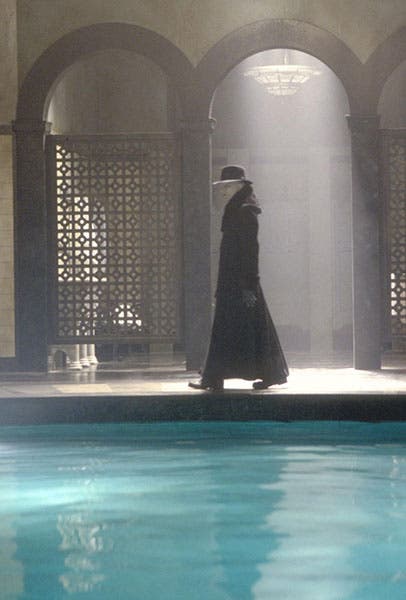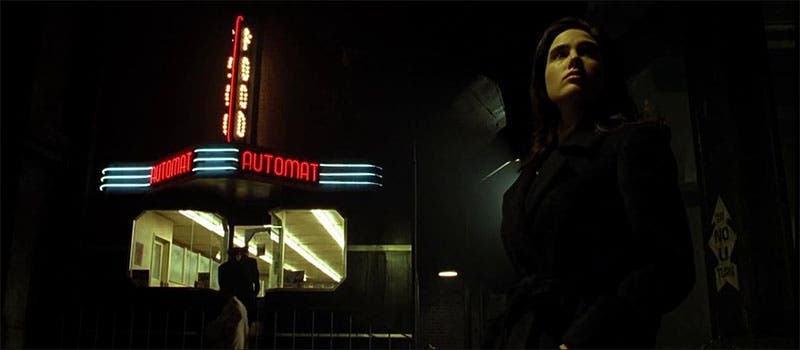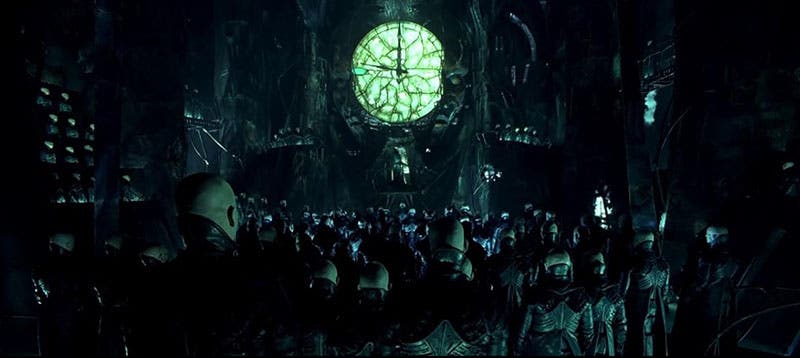Scientist of the Day - John Murdoch
Dark City, a science-fiction film, premiered on Feb. 27, 1998. The movie was directed by Alex Proyas, based on a script written by Proyas and two others. It tells the story of John Murdoch, a young man who awakens in a bathtub in a shabby urban hotel with no memory and a dead call-girl in the next room. As Murdoch escapes capture and explores the nearby environs, he comes across an automat and meets another call-girl, alive this time, and then a woman who claims to be his wife, a detective inspector out to find the murderer of six streetwalkers, including the one in Murdoch's room, and a physician who claims responsibility for Murdoch's memory loss. And Murdoch also encounters a number of "Strangers," odd-looking humans with long black trench-coats and black homburgs or fedoras who seem bent on capturing or killing Murdoch. They have strange powers; they can open doorways in blank walls, float through the air, and make people fall asleep on command (but not Murdoch). When Murdoch accidentally kills one, we learn that the Strangers are dead humans who have been reanimated by spider-like aliens (we assume) who have taken over their bodies.
As the film goes on, we discover that, the strangers, hundreds of them, live in a subterranean underworld, a cavernous area with a huge clock, manufacturing facilities, and a chemical lab, in which they create physical memorabilia, such as diaries and photo albums, and chemical memories as well, which can be injected into the sleeping citizens above (aided by the traitorous Dr. Schreber). Every night, at midnight, the big clock in the underworld stops, halting time in the world above. Everyone on the surface falls asleep, in their cars or at dinner, and the Strangers then emerge to change things. This is called “tuning.” They inject new memories or swap them around, exchange scrapbooks and alter rooms, and even construct entirely new buildings and remove old ones, with the aid of subterranean machinery. Many citizens awake with entirely new identities and memories.
It turns out that the Strangers are an alien race, with a hive mind, who do not understand how humans maintain their individuality in a complex society, and are determined to find out, through experimentation. The City, it turns out, is not part of a state or country, but a small isolated body in empty space, constructed by the Strangers and populated with captured humans. There is no Sun, so it is always dark, but oddly, although the humans in the City are fully familiar with daylight and the difference between night and day, no one realizes – until Murdoch points it out – that it is always night in the City. Murdoch learns that he comes from a community called Shell Beach, and he tries to find and return to his childhood neighborhood, but although it is on the subway map, the subway never goes there, and taxi drivers, and anyone he asks, know it well, but can't seem to remember where it is.
The story goes on and gets even stranger, but I don't want to give everything away, so I turn now to the science behind the movie. Scientists who search for evidence of extra-terrestrial intelligent life (the SETI crowd) have to deal with something called the "Fermi paradox." Enrico Fermi, the builder of the first atomic pile, was told by colleagues that, with a hundred billion stars in our galaxy, many with planets, it was extremely likely that life, and probably intelligent life, has arisen many times in the history of the galaxy. Fermi reportedly asked (this was in 1950): "So where is everybody?" If the probability of intelligent life is so great, who hasn't anyone communicated with us, or come calling?
There are many ways of dealing with the paradox, by invoking the immensity of space, or questioning our calculations when we conclude that the probability of life elsewhere is high. But some exo-biologists have proposed something called the “Zoo hypothesis." Perhaps the Earth is an interstellar menagerie, where we are being observed but not being interfered with, and are being deliberately kept isolated, until we pass some kind of test that demonstrates we are not a threat to other civilizations. That would explain the Fermi paradox. They are out there, but they are deliberately keeping their distance. If you have ever watched Star Trek and are familiar with the Prime Directive, that is another version of the Zoo hypothesis.
But there is a variant of the Zoo hypothesis, which is known as the Laboratory hypothesis. In this scenario, the aliens are already here, concealed from view, and they are experimenting on the Earth and the human race, either trying to push us in new directions, or making sure that we don’t do something dangerous to Galactic health, like blow up our portion of space. This is the world of Dark City, and it is very ingeniously explored by Proyas and his cast, which includes Rufus Sewell as Murdoch, Jennifer Connelly as his wife Emma, William Hurt as Inspector Bumstead, Kiefer Sutherland as Dr. Schreber, Richard O’Brien as Mr. Hand, an alien who pursues Murdoch, and Ian Richardson as Mr. Book, the powerful leader of the Strangers.
Dark City is one of my favorite sci-fi films, and I have always been perplexed that it is not better known and more widely appreciated. Not only does it explore the themes of the reliability of memory and our perception of reality in a very thoughtful fashion, but it is a beautiful movie to watch, shot in yellows and browns on a mammoth soundstage in Sydney, Australia. The sets are exquisite, long and deep and filled with small touches that add greatly to the verisimilitude. All of the effects are in-camera, with no CGI at hand. And since it was a moderately low-budget film, there is none of the wretched excess so common in sci-fi films today. There are many nice flourishes, such as the Stranger who inhabits the body of a 12-year-old boy (why not?), or the occasion when Murdoch buys a newspaper from a vendor who, several days before, had been his hotel night manager. I watch Dark City at least once a year, and if you like sci-fi and or movies, I hope you will give it a try. You should seek out the director’s cut, in which the introductory voice-over, inserted to satisfy a studio directive, has been removed. As a warm-up, you could watch Metropolis, and Nosferatu, and Blade Runner, and perhaps a little film noir, such as Night and the City. You will then be ready for the feature attraction.
William B. Ashworth, Jr., Consultant for the History of Science, Linda Hall Library and Associate Professor emeritus, Department of History, University of Missouri-Kansas City. Comments or corrections are welcome; please direct to ashworthw@umkc.edu.


